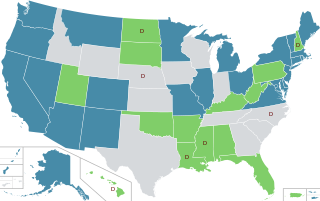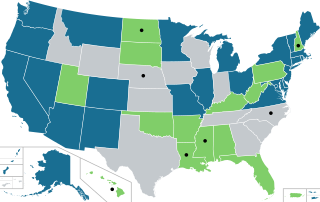
| Part of a series on |
| Cannabis |
|---|
 |
Cannabis in Vermont as of May 2004 is legal for medical use, and legal for recreational use as of July 1, 2018.

| Part of a series on |
| Cannabis |
|---|
 |
Cannabis in Vermont as of May 2004 is legal for medical use, and legal for recreational use as of July 1, 2018.
As part of a larger trend of restricting cannabis in the early 20th century, Vermont banned the drug in 1915. [1]
On May 19, 2004, Vermont legalized medical cannabis when Governor James Douglas announced he would allow Senate Bill 76 to pass without his signature. [2] The law was further expanded in June 2007 when Senate Bill 7 passed without Governor Douglas' signature once again. [3]
On June 6, 2013, Governor Peter Shumlin signed HB200 which decriminalized the possession of 1 ounce or less to a civil infraction. [4]
Vermont has taken legalization plans into consideration as early as 2014. With no initiative process in Vermont, legalization efforts went through the state legislature and had to either be approved by the governor, or be veto-proof. [5]
In 2014, Governor Shumlin stated his support for a tax-and-regulate system for cannabis. [6] A Rand Corporation study commissioned by the state in May 2014 and released in January 2015 stated that Vermont could gain $20 million and $75 million a year in tax revenue, but noted too that these sums would be vulnerable to either federal interference, or market competition if a neighboring state were also to legalize; in the latter case, Rand stated, "It is not clear that Vermont has any long-run comparative advantage in hosting the industry." [7]
In April 2015, as a form of political theater, two state representatives facetiously introduced HB502, which would re-illegalize alcohol, giving it penalties equivalent to those for cannabis. [8]
In 2015, Senate Bill 95 and House bill 277 were submitted, proposing a regulated system of legal recreational cannabis sales, however neither bill passed during the 2015 legislative session. [9]
In May 2017, the Vermont House approved a bill to allow personal possession, use, and cultivation of cannabis but not commercial sales by a 74–68 vote, while the Vermont Senate in April approved a broader bill allowing cannabis commercial sale by a 21-9 vote. On May 10, 2017, a joint bill formerly concerning fentanyl was amended to legalize cannabis, and approved by the entire state legislature, for the first time in U.S. history. [10] The bill, titled S.22 "An act relating to increased penalties for possession, sale, and dispensation of fentanyl", was amended to allow possession of an ounce of cannabis under title 18 of the Vermont Statutes Annotated. [11] [12] On May 24, Governor Phil Scott vetoed the bill, and reconsideration was blocked in June by the minority party during a one-day "veto session" of the legislature. [5] [13]
The state house voted on January 4, 2018 to pass H.511, an amended version of the 2017 bill. [14] [15] [16] The bill legalized adult personal possession of one ounce of cannabis and allows individuals to cultivate two plants. [17] The senate passed the bill by voice vote on January 10, 2018, and Governor Phil Scott allowed it to pass on January 22, by neither signing nor vetoing, becoming "An act relating to eliminating penalties for possession of limited amounts of marijuana by adults 21 years of age or older"; its provisions have taken effect as of July 1, 2018. [5] [18] [19]
The 2018 act has no sales or revenue provisions. Some legislators said they would move towards a future tax-and-regulate plan which is being studied by the governor's Marijuana Advisory Commission with a report due in 2019. [17] The legislature failed to create a tax-and-regulate system in the 2018 session. [20] [21] Regulated sales entered into law in October 2020 when S.54 went into effect. [22] State licensed medical cannabis dispensaries began selling to adults on May 1, 2022, and retailers began selling to adults in October 2022. [23]

The Marijuana Policy Project (MPP) is the largest organization working solely on marijuana policy reform in the United States in terms of its budget, number of members, and staff.

In the United States, increased restrictions and labeling of cannabis as a poison began in many states from 1906 onward, and outright prohibitions began in the 1920s. By the mid-1930s cannabis was regulated as a drug in every state, including 35 states that adopted the Uniform State Narcotic Drug Act. The first national regulation was the Marihuana Tax Act of 1937.

In the United States, cannabis is legal in 38 of 50 states for medical use and 24 states for recreational use. At the federal level, cannabis is classified as a Schedule I drug under the Controlled Substances Act, determined to have a high potential for abuse and no accepted medical use, prohibiting its use for any purpose. Despite this prohibition, federal law is generally not enforced against the possession, cultivation, or intrastate distribution of cannabis in states where such activity has been legalized. On May 1, 2024, the Associated Press reported on plans by the Drug Enforcement Administration to move marijuana to the less-restrictive Schedule III.

The legal history of cannabis in the United States began with state-level prohibition in the early 20th century, with the first major federal limitations occurring in 1937. Starting with Oregon in 1973, individual states began to liberalize cannabis laws through decriminalization. In 1996, California became the first state to legalize medical cannabis, sparking a trend that spread to a majority of states by 2016. In 2012, Washington and Colorado became the first states to legalize cannabis for recreational use.

Cannabis in Maine is legal for recreational use. It was originally prohibited in 1913. Possession of small amounts of the drug was decriminalized in 1976 under state legislation passed the previous year. The state's first medical cannabis law was passed in 1999, allowing patients to grow their own plants. The cities of Portland and South Portland decriminalized the possession and recreational use of marijuana in 2013 and 2014, respectively.

Cannabis in Montana has been legal for both medical and recreational use since January 1, 2021, when Initiative 190 went into effect. Prior to the November 2020 initiative, marijuana was illegal for recreational use starting in 1929. Medical cannabis was legalized by ballot initiative in 2004. The Montana Legislature passed a repeal to tighten Montana Medical Marijuana (MMJ) laws which were never approved by the governor. However, with the new provisions, providers could not service more than three patients. In November 2016 Bill I-182 was passed, revising the 2004 law and allowing providers to service more than three patients. In May 2023, numerous further bills on cannabis legalization and other related purposes passed the Montana Legislature. The Governor of Montana is yet to either sign or veto the bill.

Cannabis in Idaho is fully illegal for any use, whether recreational or medical. The laws on cannabis prohibition in Idaho are among the most severe in the United States, with possession of even small amounts of it a misdemeanor crime, and no legality of medical marijuana. As of 2018, support for the legalization of medical cannabis is broadly popular in the state, while legalization of the drug recreationally remains a wedge issue. Both the state's legislature as a whole and its governor, Brad Little, remain staunchly opposed to its legalization for medicinal or recreational purposes.

Cannabis in Virginia is legal for medical use and recreational use. The first medical marijuana dispensary opened in August 2020, and adult recreational use became legalized in July 2021.

Cannabis in the United States Virgin Islands is legal for recreational use since January 18, 2023, under territorial law. Legislation to legalize was passed by the territorial legislature in 2022, and was signed into law on January 18. Medical use was legalized in 2019 through a bill that passed the Senate 9–4. It remains illegal under federal law.

Cannabis in Pennsylvania is illegal for recreational use, but possession of small amounts is decriminalized in several of the state's largest cities. Medical use was legalized in 2016 through a bill passed by the state legislature.

Cannabis in New York has been legal for medical purposes under New York law since 2016, and recreational purposes since 2021. As of 2022, recreational cannabis is for sale legally in the state, only through state-approved dispensaries.

Cannabis in New Mexico is legal for recreational use as of June 29, 2021. A bill to legalize recreational use – House Bill 2, the Cannabis Regulation Act – was signed by Governor Michelle Lujan Grisham on April 12, 2021. The first licensed sales of recreational cannabis began on April 1, 2022.

Cannabis in New Jersey is legal for both medical use and recreational use. An amendment to the state constitution legalizing cannabis became effective on January 1, 2021, and enabling legislation and related bills were signed into law by governor Phil Murphy on February 22, 2021.

Cannabis in Delaware is legal for medicinal and recreational use.

Cannabis in Maryland is legal for medical use and recreational use. Possession of up to 1.5 ounces and cultivation of up to 2 plants is legal for adults 21 years of age and older. In 2013, a state law was enacted to establish a state-regulated medical cannabis program. The program, known as the Natalie M. LaPrade Maryland Medical Cannabis Commission (MMCC) became operational on December 1, 2017.

Cannabis in Connecticut is legal for recreational use since July 1, 2021. Medical use was legalized through legislation passed in 2012.

Cannabis in Ohio is legal for recreational use. Issue 2, a ballot measure to legalize recreational use, passed by a 57–43 margin on November 7, 2023. Possession and personal cultivation of cannabis became legal on December 7, 2023, with the first licensed sales yet to occur under the law. Prior to legalization, Ohio decriminalized possession of up 100 grams in 1975, with several of the state's major cities later enacting further reforms.
The Cannabis Regulation and Tax Act is an act legalizing and regulating the production, consumption, and sale of cannabis in Illinois. It was approved by both houses by May 31, 2019 and came into effect January 1, 2020.